IBC 2023 is set to take place Sept. 15-18 in Amsterdam. Here are just a few products to add to your list.
Canon to Unveil 4K PTZ Camera, Remote Camera Controller, and RF-Mount Cinema Prime Lenses
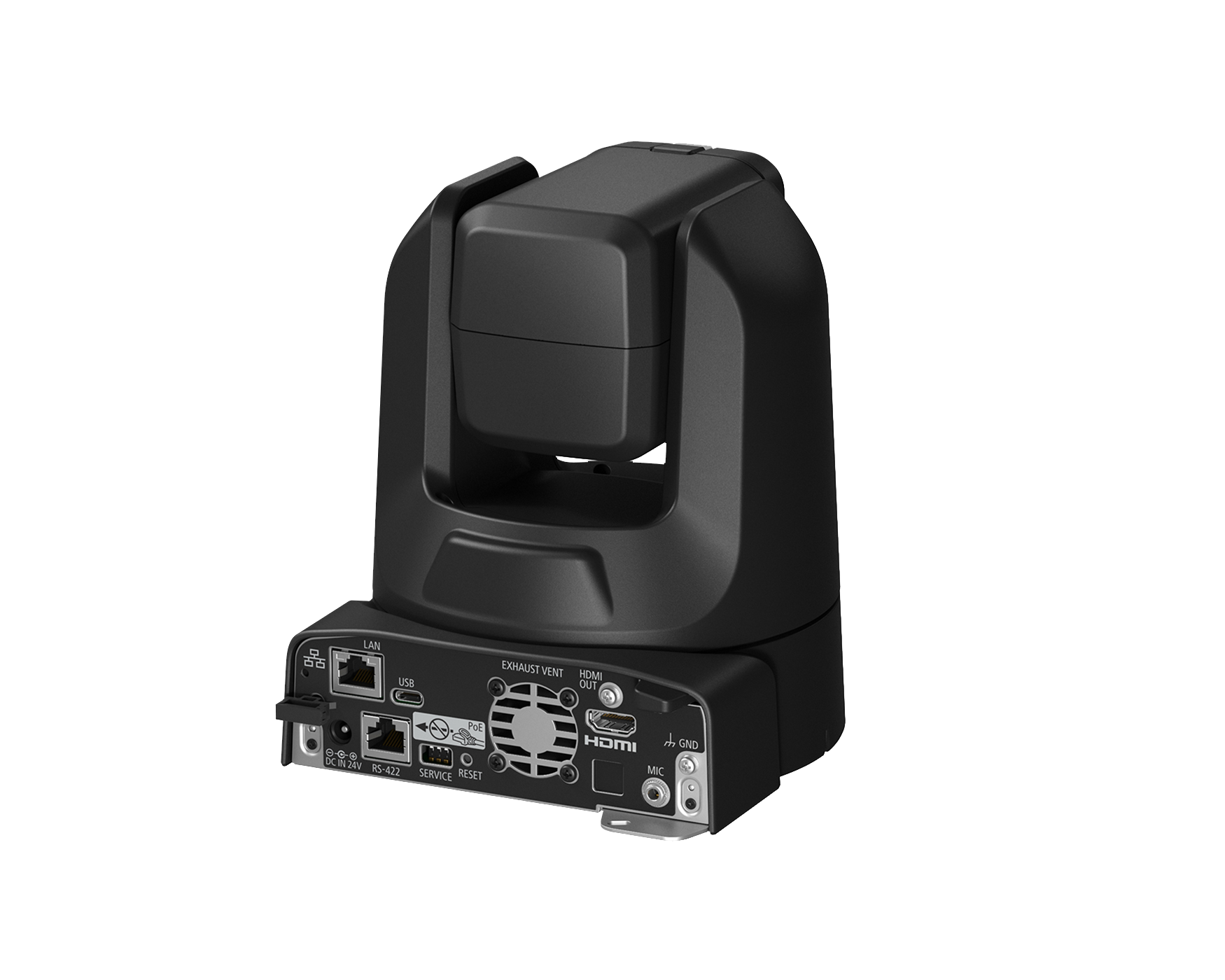
At IBC, visitors to the Canon booth will be able to see the new CR-N100 4K PTZ camera. The camera is designed for indoor use cases and brings the image quality and performance that Canon PTZ cameras are known for. Canon is also introducing the RC-IP1000, a high-end remote camera controller designed for professional systems. As a free download, Canon will also release the Multi-Camera Management Application that streamlines the configuration and management of supported Canon PTZ, professional video, and cinema cameras.
[Canon Collaborates on Collaboration]
As online meetings, lectures, live events, and seminars become increasingly commonplace, there is a growing need for livestreaming and video recording technology. The CR-N100 camera provides excellent image quality, fast autofocus, and its compact size allows for easy installation in spaces such as meeting rooms and classrooms. With the addition of the CR-N100 to Canon’s lineup of remote cameras, customers now have greater choices of products that support a wide range of uses, from professional video production to video content use by markets such as corporate, local governments, house of worship, and educational institutions.
Also on display with be Canon's first RF-Mount Cinema Prime Lenses for the Cinema EOS System. The new lenses combine high optical performance for 4K and 8K shooting, cinema-style operability, and RF mount communications. The first set of seven RF-Mount Cinema Prime Lenses is only the beginning. Canon plans to swiftly expand the lineup of RF-mount-compatible video production equipment to meet the needs of professional video production of such content as movies, TV, and commercials.
The seven Canon CN-R lenses, with focal lengths and T stops of 14mm T3.1, 20mm T1.5, 24mm T1.5, 35mm T1.5, 50mm T1.3, 85mm T1.3, and 135mm T2.2, are compatible with the two existing RF-Mount Canon Cinema Cameras, the EOS C70 and EOS R5 C. These lenses will allow for RF mount protocol transmission, and just like the EF-Mount Cinema Prime Lenses, operators can control magnification, chromatic aberration correction, peripheral light correction, and a dual-pixel focus guide via camera body operations. In addition, the new lenses also feature lens distortion correction. These features support efficient video production during on-location recording and post-production workflow.
Magewell to Launch All-in-One Live Production and Streaming System
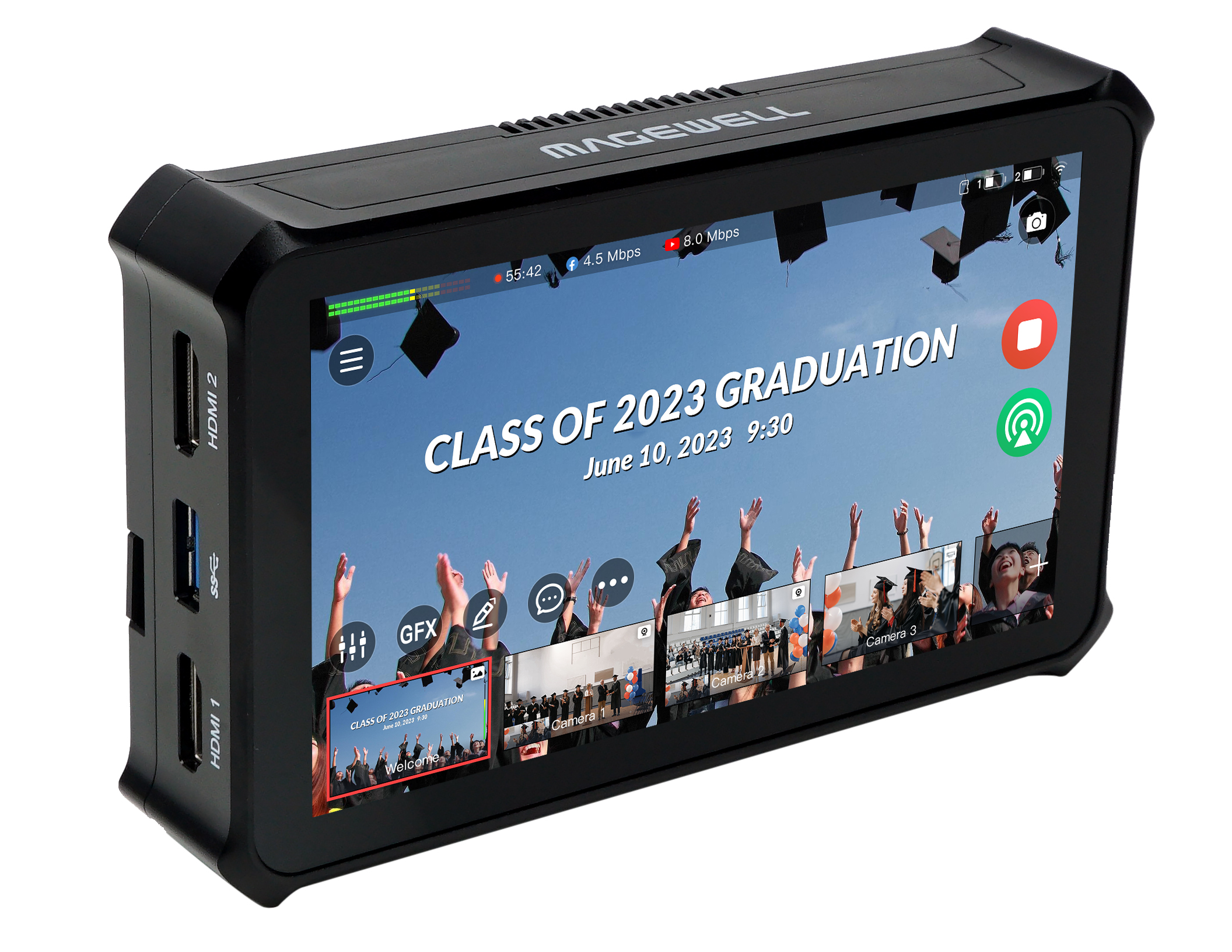
Magewell (stand 7.A44) will launch its first self-contained, full-featured production solution, Director Mini. Combining multi-input switching, graphics, streaming, recording and monitoring in one compact device, Director Mini enables a single operator to easily create visually compelling productions for live event coverage, remote production feeds and more.
Director Mini offers a unique combination of input source flexibility and feature richness in an exceptionally versatile form factor. Users can switch between two HDMI inputs and two USB AV inputs as well as three simultaneous live IP sources including SRT streams, RTMP streams or up to two NDI HX sources. File-based media assets including video, audio and images can also be combined freely with live sources. Embedded audio is supported on the HDMI and USB inputs alongside a 3.5mm analog audio input.
Director Mini's intuitive user interface is accessed through its integrated 5.44-inch AMOLED touchscreen. Users can define multiple scenes that combine live HDMI, USB and audio inputs with network streams, media sources and graphics, then switch or transition between these scenes on the fly. Chroma keying enables the use of virtual backgrounds, while telestration enables real-time on-screen drawing and combines with built-in scoreboard functionality to support sports productions. PTZ camera control is also available through the touchscreen, simplifying single-operator productions.
Director Mini can encode video up to 1080p at 60 frames per second and bitrates up to 30Mbps, with a flexible array of output possibilities. Productions can be streamed using the RTMP protocol to popular platforms such as YouTube™ Live, Facebook™ Live or custom destinations. Live comments can be displayed while streaming to YouTube, Facebook or Twitch. The ability to output an SRT stream makes Director Mini an excellent tool for contributing high-quality feeds to an off-site location for remote production. Alternatively, the device can create one NDI® HX output to serve as a source for additional IP-based production tools. Its USB-C port can be configured to display the program output, user interface or a loop-through of either HDMI input on a connected USB-C display. Last but not least, content can be recorded to an SD card, USB flash drive or the device's internal storage.
Wisycom Introduces New Full-duplex Mobile Transceiver
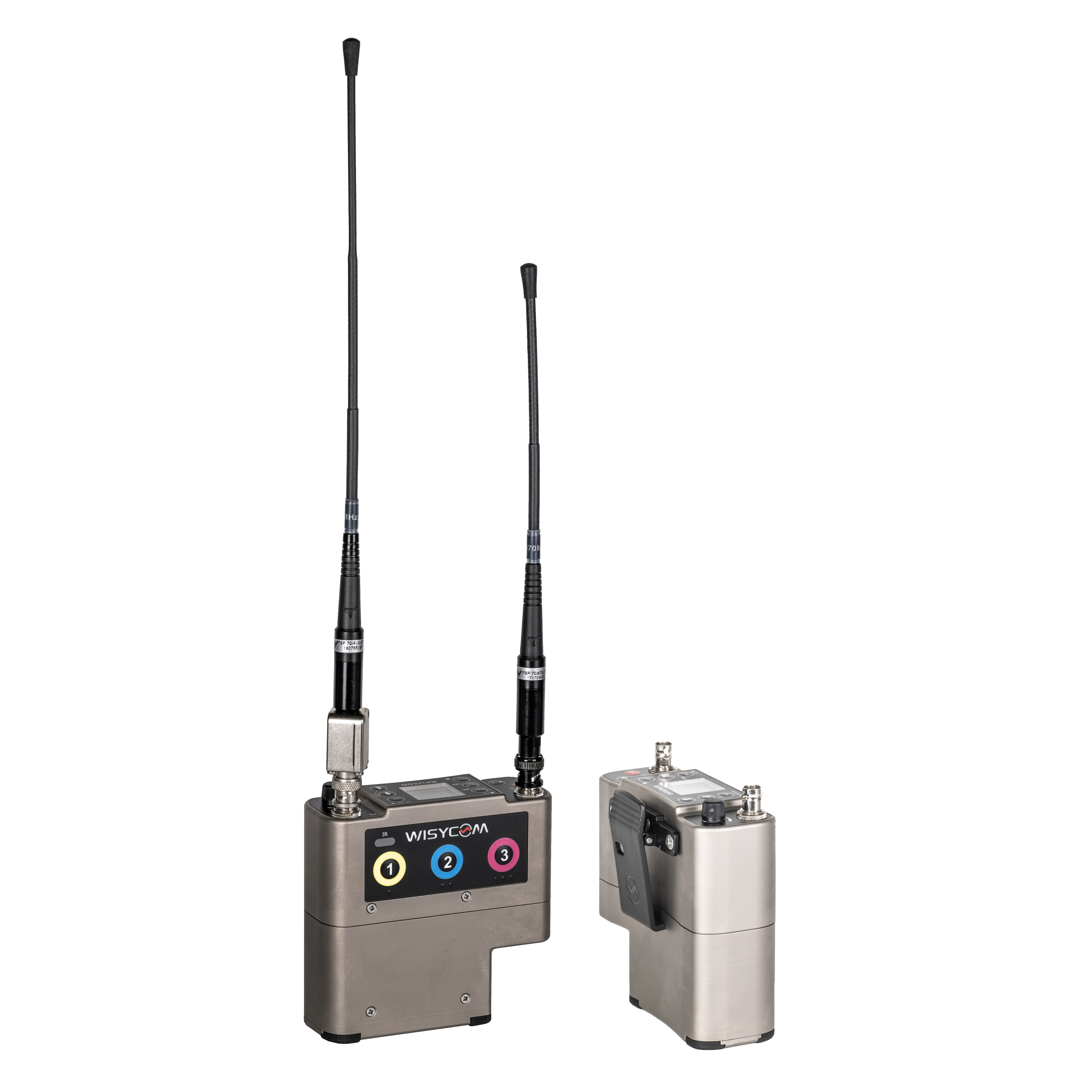
Wisycom will unveil its new RPU500-F full-duplex mobile transceiver in Hall 8, Stand C51. Designed for sports, live events, and outside broadcast commentator coverage, the transceiver features a 1W multiband transmitter (where applicable) with a newly designed integrated intercom/IFB receiver.
The RPU500-F features an ergonomic and compact form (73.1x64.5x21.6mm) that makes it perfect for use in live applications requiring a lot of movement. With a battery pack that lasts more than five hours with continuous high-power transmission, the RPU500-F is also well-suited to applications where long coverage periods might be required. Additionally, the transceiver’s transflective LCD color display ensures that it is legible in all lighting scenarios—including direct sunlight, which is ideal for sports and other outdoor events.
[AV Takes Command at FedExField]
The transmitter operates in the 174-960MHz spectrum, while the receiver works in the 440-700MHz range and can operate in three modes, which are selectable on the device menu. This includes ultra-narrowband (channel bandwidth 12.5k), narrowband (50k) and narrowband enhanced (110k). The bandwidth provided by the enhanced mode makes it possible to include up to three embedded audio sources on the same device. The device also features four programmable push-to-talk buttons for remote audio routing on AUX or through Ethernet with Ember+.
Designed to work with the Wisycom Symphony Series receivers and MTK Series transmitters, the RPU500-F provides users with an unprecedented, broadcast-quality, full-duplex, long-range wireless reporting system.
Get the First Look at LiveLink from Vislink
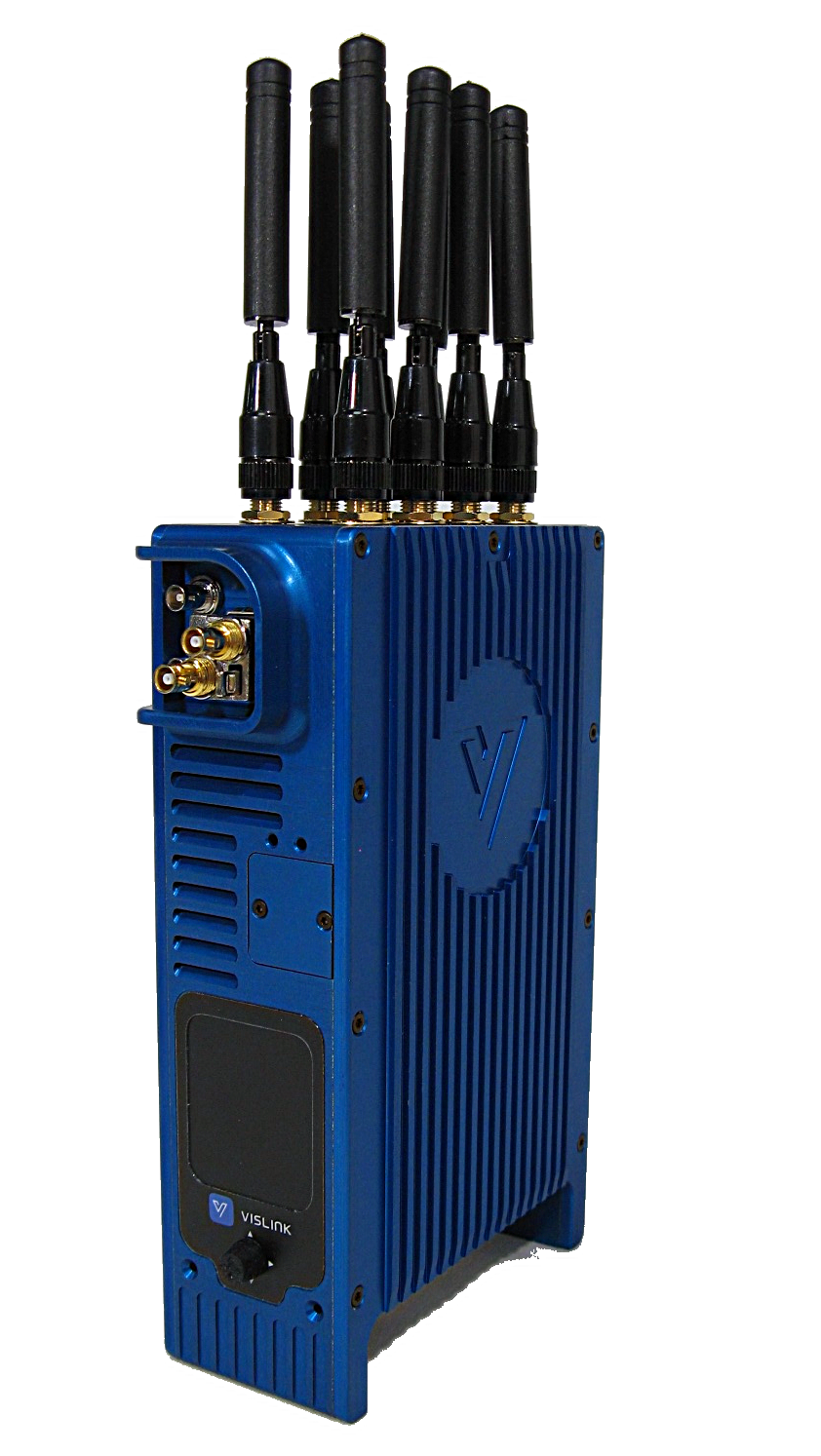
Visitors to the Vislink Technologies Hall 1, Stand 1.C51 will witness the world debut of WMT LiveLink, a bonded cellular transmitter. Based on Mobile Viewpoint technology, LiveLink’s design offers high-quality 4:2:2, 10-bit HEVC video encoding up to 4K resolutions, and 10-bit Luma Optimization to meet the demands of HDR.
With LiveLink, broadcasters can leverage high-quality, low-latency video transmissions—made possible by FPGA technology and HEVC encoding—to enable dynamic, highly-fluid two-way interviews.
LiveLink provides bonding connectivity, supporting up to four diverse public cellular connections, Wi-Fi, and public internet. Those in heavily populated environments can still enjoy high data rate connectivity through integration with Vislink’s private 5G connectivity solution. With bonded cellular, private 5G and Starlink satellite support, LiveLink also provides seamless roaming across private and public 5G networks.
Field camera operators can stay connected to colleagues in the broadcast center through a direct audio link provided by LiveLink’s integrated camera control feature. LiveLink also includes multi-camera/transmitter synchronization, allowing users to seamlessly switch between live feeds, viewing the action from different angles.
ENCO to Showcase Augmented Reality Experiences
ENCO will unveil an integration of virtual production and PTZ technology from its Qimera and RUSHWORKS product lines at stand (8.C73). Visitors will see the two technologies working with a 3D camera tracking system to enable augmented reality (AR) environments for live studio-based TV and visual radio productions.
ENCO acquired RUSHWORKS in January and was named the exclusive North American distributor for Qimera in June, adding two product brands that bring exciting new production capabilities to ENCO customers. At IBC, ENCO will demonstrate how broadcasters can create appealing AR experiences for live broadcasts by blending Qimera’s compositing systems with the award-winning RUSHWORKS PTX Model 3 PRO pan/tilt head. Visitors will ultimately step into an AR environment with professional live graphics powered through Qimera’s Unreal Engine plug-in, with the PTX Model 3 PRO pan/tilt head ensuring a cinematic feel to the visual experience thanks to smooth, whisper-quiet operation. The resulting AR experiences will be reflected on the walls and floors at ENCO’s stand and fully visualized on a large monitor so that visitors can precisely understand the AR production elements being used to bring the visuals to life. Qimera’s built-in video-switching technology will drive the visual output.
[We Went for an Off-Road Adventure with Vú at InfoComm 2023... and It Was Awesome]
Qimera’s real-time virtual production compositing tools were built with modern production workflows in mind, beginning with its easy and intuitive user interface. Editors can quickly create highly advanced virtual sets and augmented reality graphics thanks to its quick learning curve, and users can connect four cameras to a single server thanks to its built-in video switcher. The solution builds in lighting control with DMX IP, PTZ camera integration, a 3D assets library, realistic graphics via Unreal Engine, multi-layer composition, and a virtual crane among other features.
The RUSHWORKS PTX Model 3 PRO pan/tilt head features passthrough connections for SDI, HDMI, USB, DC camera power, and networking between cameras and lenses, minimizing stress between the base and arm. Made of steel and aluminum, the PTX Model 3 PRO provides a solid platform for smooth presets and on-air moves. The PTX Model 3 PRO provides the torque necessary for smoothly controlling most pro-grade camera/lens combinations, including models from Blackmagic Design, Canon, Panasonic/Lumix, Red, Arri, Sony, and more.
Genelec to Launch UNIO Audio Monitoring Platform and 9320A Reference Controller
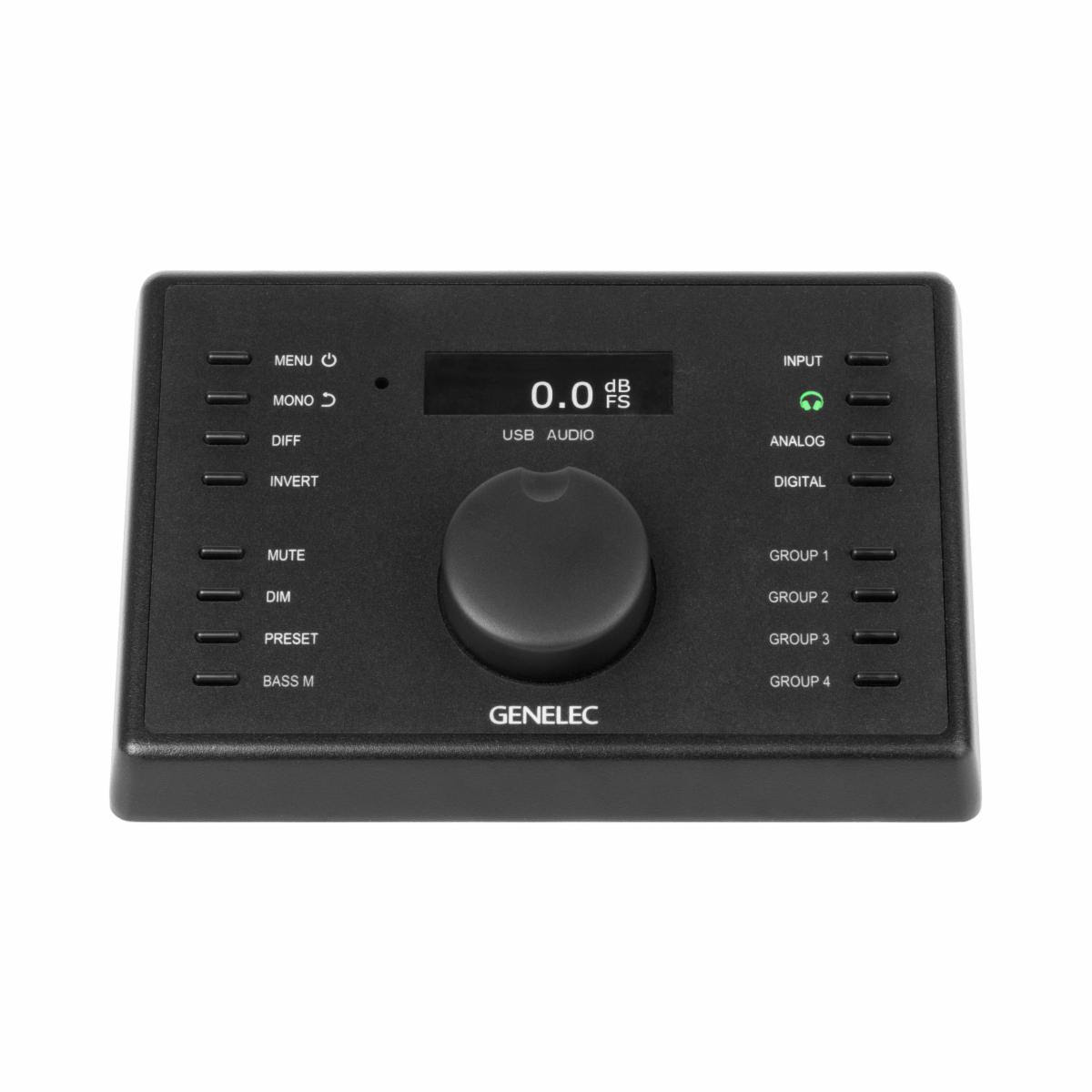
Genelec will unveil the 9320A Reference Controller as a bridge to its brand new UNIO Audio Monitoring Service Platform. UNIO brings together all the benefits of Genelec Smart Active Monitors, GLM 5.0 calibration software and Aural ID 2.0 technology to create seamless integration between professional in-room loudspeaker and headphone monitoring services. With flexible connectivity, a reference-grade headphone output, and tactile hardware control of Smart Active Monitors, GLM, and Aural ID, the 9320A provides a compact hub for both static and mobile professional audio monitoring applications.
Genelec’s range of Smart Active Monitors power the UNIO platform, which utilize auto-calibration and cloud computing to enable the production of accurate, reliable mixes that translate consistently to other rooms and systems. For professional headphone users, Genelec’s Aural ID technology provides a completely personal and truthful headphone listening experience with the natural sense of space and imaging provided by in-room monitoring. By combining a calibrated Smart Active Monitoring system and professional headphones with Aural ID, the user is able to have mixes that translate reliably between monitors and headphones.
Now, with the introduction of UNIO and the 9320A, users can integrate these technologies and services via a single intuitive mobile desktop device, and view the entire system via the user’s MyGenelec account. As a bridge to UNIO, the 9320A offers management of multiple Smart Active Monitoring systems from stereo to immersive and beyond, and comes complete with a factory-calibrated reference microphone to allow automated system calibration and control of key GLM software features.
The introduction of UNIO and the 9320A also coincides with the latest GLM 5.0 loudspeaker manager software release, which provides support for both the 9320A and the flagship 8381A free-standing main monitor unveiled earlier this year. GLM 5.0 employs sophisticated cloud computing, enabling UNIO to effortlessly integrate a range of reference audio monitoring services, including intelligent room analysis, in-room system calibration, monitor control and fully personal audio monitoring.
Studio Technologies Introduces VenueView
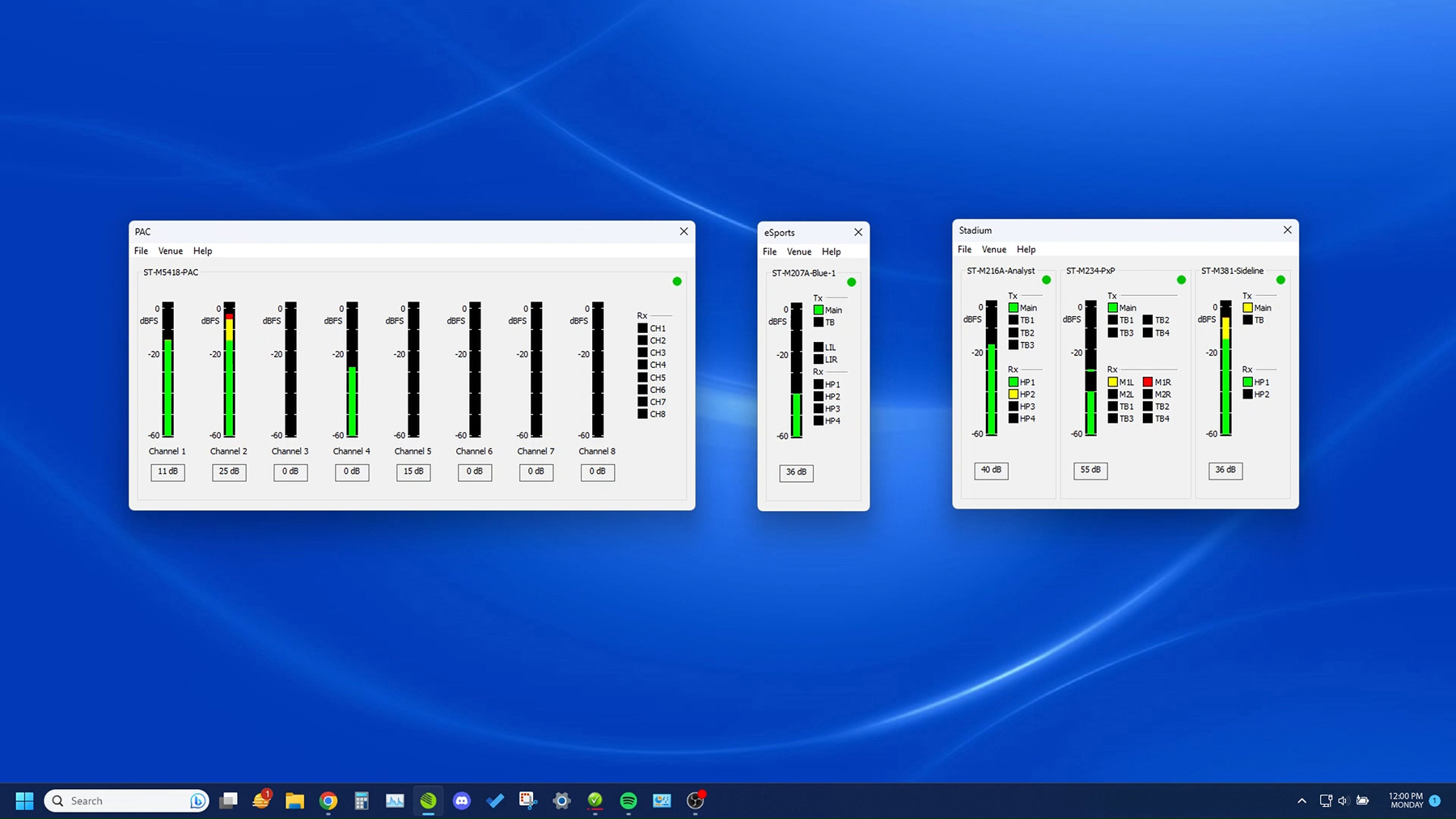
Studio Technologies unveils its newest STcontroller application feature, VenueView, at stand 8.F93.
STcontroller is Studio Technologies’ proprietary personal computer application. It offers a quick and easy means of displaying and real-time monitoring of key operating parameters associated with a number of different Studio Technologies’ Dante-compatible products. The focus of VenueView is to assist support personnel who are responsible for the correct operation of multiple announcer’s consoles (talent interfaces) and related devices that are being used by “on-air” personnel in broadcast and production applications. The latest release of STcontroller for Windows, available on the Studio Technologies web site, adds the VenueView capability. Each VenueView group allows up to eight different devices to be monitored in a single user-defined menu, with multiple groups capable of being simultaneously monitored. Additional capabilities are planned for future VenueView releases.
MultiDyne's HoneyBadger Makes European Debut
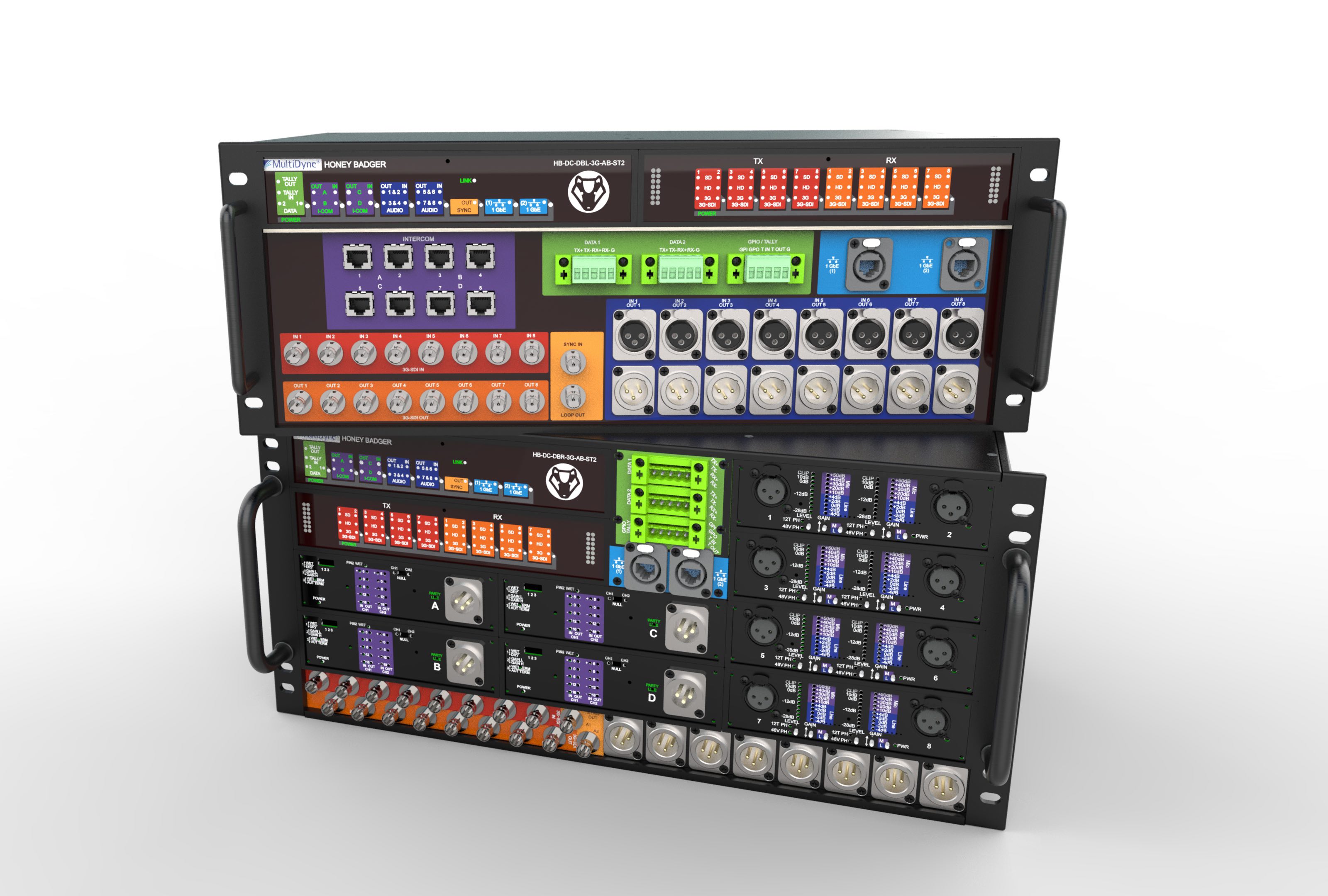
At IBC, MultiDyne will highlight new product innovations and strategic acquisitions that take the company deeper into the technology infrastructure, allowing customers worldwide to embrace new opportunities in live production, media transport and content delivery.
MultiDyne, which has also relocated its headquarters to a larger facility outside New York City, will show two recently introduced products at IBC for the first time at IBC.
The MultiDyne new HoneyBadger solution is one of those new solutions being highlighted. HoneyBadger is built for a new generation of content producers faced with a broader array of formats, signals and connectors while seeking to bridge the gap between fiber and IP. It scales to serve the expanse of any production workflow or requirement so that everything the content producer needs for multi-camera or multi-announcer productions converges within its design.
With support for eight camera feeds and SDI return channels, the design also includes two independent 1Gb local-area network (LAN) extensions, enabling IP connectivity over single-mode fiber strands. Customers can also extend four partyline intercom channels (wet or dry), eight bi-directional line level analog audio outputs and eight mic-pre inputs with phantom power over two cost-efficient single-mode fibers.
Pixotope Makes Virtual Production a Reality for Broadcasters of All Sizes
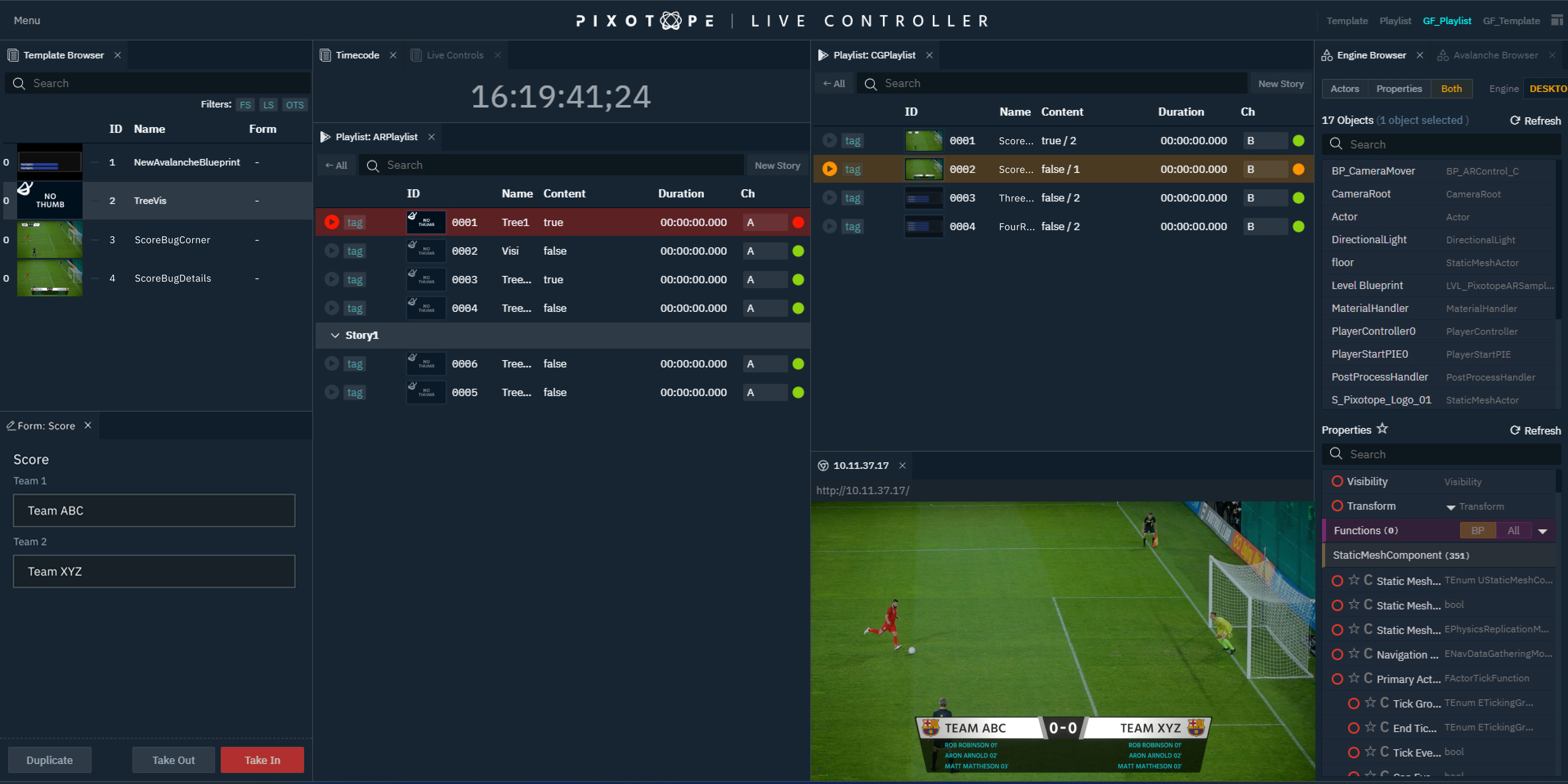
Pixotope is set to unveil its new Live Controller, an all-in-one graphics control solution for broadcast virtual production workflows. Underpinned by Unreal Engine, the Pixotope Live Controller introduces reusable no-code templates and rundown-based virtual production workflows to all broadcast control rooms in a single-user software package. For the first time, any broadcast operation, regardless of size, can easily implement virtual production as part of its programming without bespoke engineering teams to synchronize the separate graphics pipelines needed to bring CG, AR, XR, and virtual sets together on air.
Three things to know about the Pixotope Live Controller
- Enhanced Graphics Engine: Through seamless integration with existing workflow components, broadcasters can maintain the same look and feel their users expect, minimizing disruption while maximizing the advantages of the new technology.
- Simplified Integration and Support: Broadcasters eliminate the need to collaborate with multiple vendors, streamlining the licensing process and ensuring a single point of contact. This simplified approach saves time, reduces complexity, and eliminates uncertainty when issues arise.
- The Power of Templates and Playlists: Live Controller empowers broadcasters by implementing templates — combinations of graphic assets, data, and user input forms—that will be instantly familiar to all users while providing access to the latest graphics engine. These templates can be saved in a database and reused effortlessly, allowing broadcasters to create playlists for their shows. This flexibility enables easy customization, as broadcasters can mix and match templates, overlaying different elements and achieving dynamic visuals without starting from scratch. Future releases of Live Controller will enable time and cost savings by introducing the capability to reuse assets generated by journalists and facilitating efficient collaboration between studio automation and post-production.
Celebration Time at IBC 2023: RAVENNA and AES67

This is the opposite of a new product, but certainly newsworthy. RAVENNA will celebrate its 13th anniversary at IBC 2023. This year, RAVENNA shares the festivities the AES67 Standard for High-Performance Audio-over-IP Interoperability (first published at IBC 2013) marks its 10th anniversary at IBC 2023. Since then, all existing AoIP solutions—including Livewire, QLAN, Dante, Wheatnet and others—have adopted AES67 as an operational mode or profile, allowing some 2000-plus products to interoperate. A series of successful plugfests were held across Europe and the United States to prove that AES67 has a sound foundation and achieves its goal: interoperability amongst equipment from a wide range of manufacturers.
AES67 also forms the basis for the suite of SMPTE ST 2110 standards for Transport of Professional Media over Managed IP Networks. ST 2110-30 describes the transport of linear PCM audio and builds directly on AES67. For ST2110-31 (Transport of AES3 Audio), SMPTE decided to adopt the existing RAVENNA AM821 definition, making RAVENNA the most suitable technology both for building AES67-enabled products and systems and implementing SMPTE ST 2110 into devices. Beyond the mandatory requirements defined in AES67 and ST 2110, RAVENNA offers a wider choice of formatting options, more flexibility for any size of applications and as well as superior performance options for the most demanding requirements of professional broadcast productions.
AES67 has seen two revisions—the latest being published in 2018. The AES67 Task Group continues its work on maintaining AES67 and is looking forward to publishing the third revision of AES67 towards the end of 2023. With the RAVENNA team participating in the work groups of various standardization organizations, adopters can be assured that RAVENNA is always aligned with current and emerging standards requirements.
The RAVENNA team can be found in stand 8.F57 where it will be demonstrating AES67 interoperability and showcasing a number of new AES67 and ST 2110-enabled products from various RAVENNA partners.
